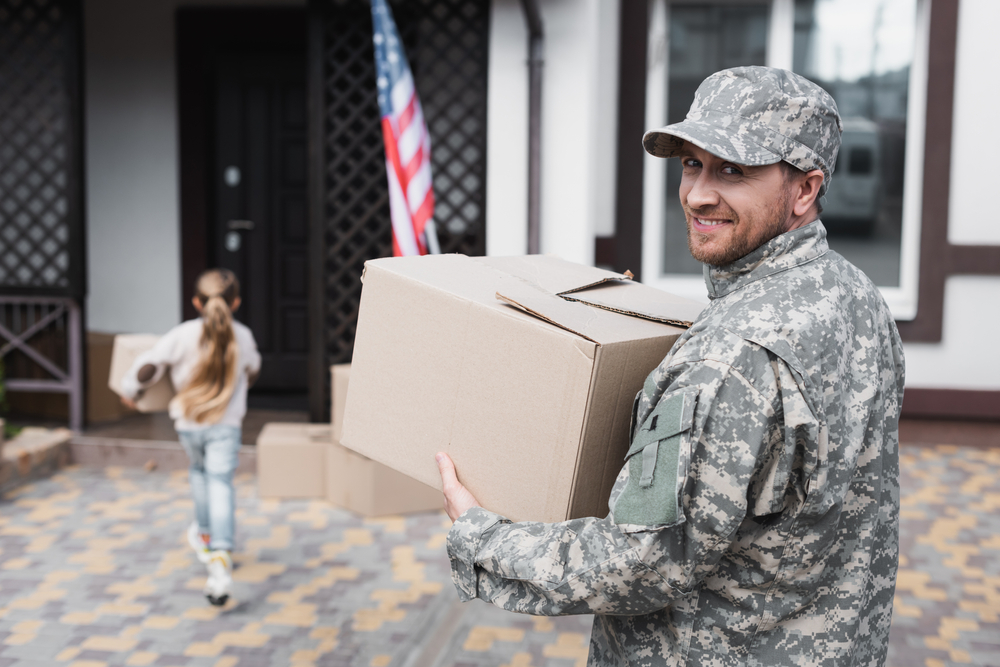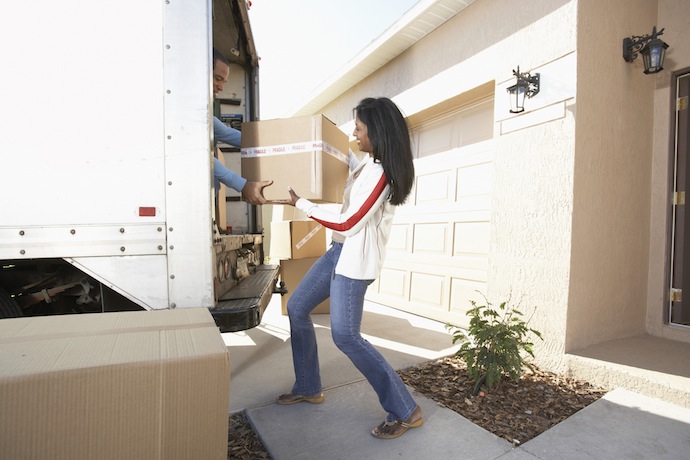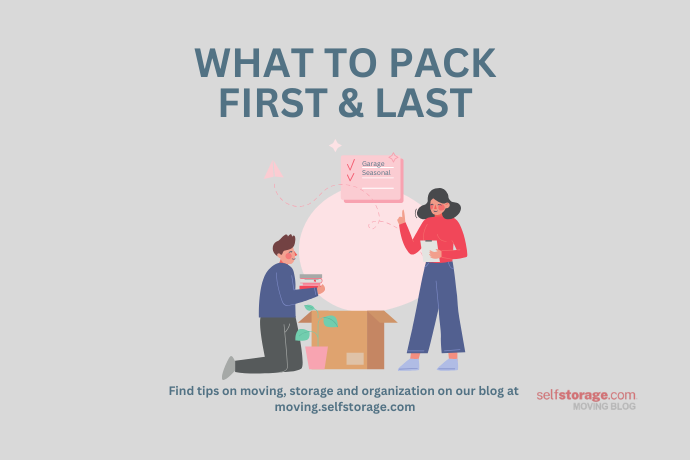Let’s face it, preparing to move can be one of the most stressful things we face as adults. But it doesn’t have to be. We’ve created a guide that lays out the tasks you need to tackle when getting ready to move, from decluttering to self-care. Spoiler alert: organized packing for a move is just a matter of making a simple plan! Read on for a step-by-step roadmap to a smooth moving experience.
What’s covered in this article – click on a link to learn more:
- Create a moving checklist
- Assess your moving needs
- Declutter and downsize
- Gather packing supplies
- Create a packing plan
- Organize important documents
- Arrange childcare and pet care
- Prepare a moving day essentials box
- Take care of yourself
Create a Moving Checklist
Before you grab the boxes and tape, take a few minutes to get organized. Moving checklists can be a great place to start, especially if you’re getting ready to pack for a cross-country move. You’ll want to go through each room of your home and create a checklist of what needs to be packed, and what you’ll need to leave out until the last minute. If you live with others, divide and conquer. Create checklists for who is in charge of what so your packing plan for moving is crystal clear. Prioritize tasks and create deadlines, (i.e. “get the storage room decluttered by Friday.”) Don’t forget to add a pantry cleanout to your moving checklist! No need to move expired food from one home to another, so toss anything that’s past its prime.
Assess Your Moving Needs
If you’ve decided to move, there’s one big question on your mind. “Do I need to hire movers?” Libby Huffines, a professional organizer and owner of Libby and Labels, LLC, says it’s always a wise investment to hire professional movers. “It will always take longer than you think and cause more stress when you try to do it on your own,” she said. There are many factors you need to consider when making this decision.
- Are you moving across the parking lot or across the country?
- Do you have time available for full days of packing, moving, and unpacking?
- Does your budget allow for movers?
- Do you have friends and family on both sides of the move who would be willing to spend a day or more moving boxes and furniture?
In order to figure out the budget piece of this puzzle, you’ll want to gather a few moving quotes. One option to start this process is by using Angi, a site where you can enter basic details about your move and get recommendations for highly rated movers. If you do decide to use a moving company, make sure that you read reviews and verify that it’s a reputable business before making the deposit. And beware of any unexpected additional fees prior to moving day.
Huffines says looking for pricing somewhere in the middle is typically better than avoiding the cheapest option or thinking you need to go with the most expensive moving company. And don’t be afraid to look outside of the box when it comes to companies you enlist to help. “I’d recommend hiring professional organizers or a similar company for packing as they will typically pack with more care and thoughtfulness than the typical moving company,” she said.
Don’t be afraid to negotiate with moving companies or truck rental companies to get a better deal. Ask for discounts or promotions, and see if they are willing to match prices with their competitors. Many companies offer discounts for students, seniors, veterans, AAA members and other groups.
If you are downsizing, you may want to consider renting a storage unit.
Declutter and Downsize
One of the best packing tips we can offer is don’t bring anything you don’t need! A good rule of thumb is if you haven’t used something in a year (whether it’s a sweater or an exercise bike), you should probably let it go.
Also consider what items may have served you in your current home but will become obsolete in the new location. Are you moving to a new area where it never snows? You may want to get rid of items you won’t use for your new place by donating them or having a yard sale. Many communities have “Everything Is Free” Facebook groups that allow you to put items outside your home for others to pick up. Who knows, maybe the item that you no longer need is just what someone else was looking for!
Gather Packing Supplies
If you’ve decided to go for movers, some companies provide you with all the materials you need but may have certain specifications prior to moving day. “Many movers require you to take TVs off of walls and to unhook washing machines and dryers before they arrive,” Huffines added. “Check with your moving company on what they require and schedule a handyman if you need additional help with these tasks.”
However, if you’re doing some or all of the packing yourself, you’ll need to obtain some supplies. Here are some basic packing materials you’ll need:
- Moving Boxes – a variety of sizes
- Packing Paper – old newspaper or craft paper
- Bubble Wrap
- Tape – scotch tape to secure bubble wrap and packing tape for the boxes
- Markers – in different colors to designate specific rooms or fragile items
You can always go to Home Depot or other similar stores to buy boxes, but it’s worth checking out some potentially cheaper options as well. Your local recycling center may have boxes available, and it doesn’t hurt to ask at the supermarket. Stores like that go through thousands of boxes and are sometimes willing to give them away for free. Finally, the “Everything is Free” group in your community often has someone who has just moved and is looking for a place to donate used but functional boxes.
This handy packing calculator will help you determine how many boxes you’ll need to pack up your home. And then add to that number as Huffines says you’ll always need more boxes than you think, and it’s easier to have too many than scrambling for more when it’s crunch time.
Create a Packing Plan
Some tasks can be left until the last minute. Packing for a move is not one of them. Give yourself weeks of prep time. Work backwards from the move date and plan to work on pre-move tasks for a period of time every day. Assign specific days or time slots for different packing activities. This will ensure you’re not frantically throwing shoes, spices, and golf balls into the same box hours before the moving truck arrives!
The big tasks will feel more manageable if you break them into smaller steps. For example, if the kitchen packing feels like too much, start with the serving dishes that you probably don’t use every day. Then move to the tupperware (leaving out a few for those last few weeks).
The amount of time you give yourself will differ based on how big your current home is and how many items you have to move. For example, a small studio apartment or one-bedroom house may only take a few days, while a larger home can take a week or longer to pack up properly.
Below is a breakdown of how much time you should allot based on the size of your home:
- Studio or 1-bedroom apartment: 2 days
- Two-bedroom home: 3-4 days
- Three-bedroom house: 4-5 days
- Four-bedroom home: 5-6 days
- If you have a garage, attic or basement they also recommend adding an extra day for each space.
In addition to having a packing plan, take time to consider how unpacking might look in the new place. “If you take photos of the rooms and furniture at the old home, it will give you an ‘inventory’ so you can easily set items back up correctly in the new one,” Huffines said.
Huffines also advises to leave yourself some time when going in between the two locations. “If possible, try to leave yourself a little buffer of time before you have to be out of your current place in order to tie up loose ends. It helps to not feel as rushed,” she said.
Organize Important Documents
No matter how flawlessly we plan, things can get lost on moving day. That’s why it’s essential to store important documents in a designated folder or box. You may want to keep this box with you rather than have the movers take it along with your other items. These days, a digital scan is a super simple task, so take a few extra minutes (using an app like Scannable) to create digital copies of your most important documents, just in case.
Arrange Childcare and Pet Care
If you have kids or pets, you probably don’t want them around on moving day. Set up playdates, babysitters, pet sitters, or anything you need to make sure that you can focus on the move. It’s also not safe to have small children and pets around when large items are being moved, as visibility is restricted and heavy items are not anchored to the wall.
Prepare a Moving Day Essentials Box
As your move approaches, think about the things you use every day. Toiletries, medications, kitchen items, clothing, shoes and outerwear, keys, work materials, etc. These items should be kept in a separate bag that will stay with you, not with the movers. Your important documents should also be included. This moving day essentials kit will save you lots of time that you might otherwise have spent clawing through boxes looking for your important belongings in your new home.
Take Care of Yourself
Moving can be stressful and exhausting, even in the best of circumstances. Take time for self care in the weeks before, during, and after your move. Get enough sleep, stay hydrated, and try to eat nutritious meals. If you’re feeling overwhelmed, reach out to friends and family. Chances are, they’ve been in the same situation at some point and will be glad to lend an ear. If you start the planning process early, you will have built-in time for breaks and moments of relaxation that can motivate you to get to the finish line!
At the end of the day, the best way to pack for moving is to make a plan. Approach this methodically, take your time, and tackle each step individually. Trust us, you won’t regret taking the time to organize the process. Best of luck on your new adventure!







